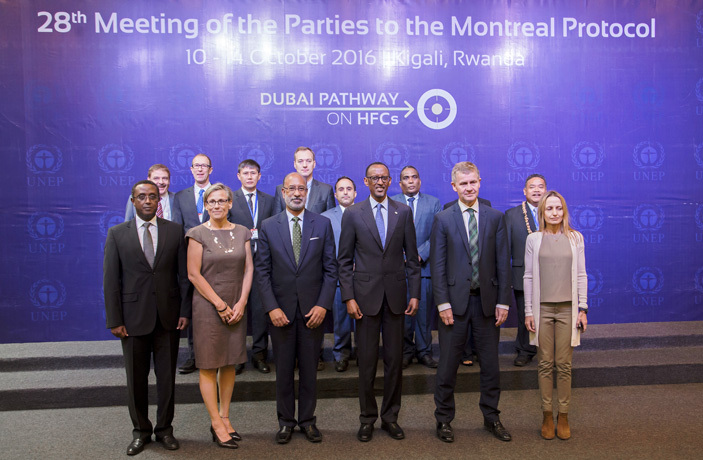World urged to scrap super greenhouse gases at Rwanda summit
Oct 13, 2016
Envoys from nearly 200 nations are in the Rwandan capital to thrash out an agreement to phase out hydrofluorocarbons (HFCs)

PIC:Rwandan Minister of Natural Resources Vincent Biruta (L) looks on as Executive Director of UNEP Erik Solheim (C) shakes hands with Rwandan President Paul Kagame during the official opening of the 28th meeting of the Parties to the Montreal Protocol in Kigali on October 13, 2016. AFP photo / Cyril Ndegeya
Rwanda's President Paul Kagame urged world leaders to rid the world of potent greenhouse gases used in refrigerators and air-conditioners, as he opened a high-level meeting in Kigali Thursday.
Envoys from nearly 200 nations are in the Rwandan capital to thrash out an agreement to phase out hydrofluorocarbons (HFCs), which were introduced in the nineties to save the ozone layer, but turned out to be catastrophic for global warming.
Halting the use of HFCs -- also found in aerosols and foam insulation -- is crucial to meeting the goals to curb the rise of global temperatures agreed in a historic accord signed in Paris last year.
"We should not allow ourselves be satisfied with making a little bit of good progress when it is within our power to actually solve the problem," Kagame told the meeting, attended by representatives of 197 countries.
Among the 40 ministers expected is US Secretary of State John Kerry.
Kagame, whose small east African nation has put the environment at the heart of its development, said that doing away with HFCs "will make our world safer and more prosperous".
 Rwandan President Paul Kagame (3rd R) poses with participants during the official opening of the 28th meeting of the Parties to the Montreal Protocol in Kigali on October 13, 2016. AFP Photo / Cyril Ndegeya
Rwandan President Paul Kagame (3rd R) poses with participants during the official opening of the 28th meeting of the Parties to the Montreal Protocol in Kigali on October 13, 2016. AFP Photo / Cyril Ndegeya
Erik Solheim, head of the UN Environment Programme, called on delegates to be "ambitious" in their discussions.
"No one, frankly, will forgive you nor me if we cannot find a compromise at this conference because this is one of the cheapest, one of the easiest, one of the lowest hanging fruits in the entire household of climate mitigation."
HFCs predecessors, chlorofluorocarbons (CFCs), were discontinued under the ozone-protecting Montreal Protocol when scientists realised they were responsible for the growing hole in the ozone layer, which protects Earth from the Sun's dangerous ultraviolet rays.
However it emerged that HFCs -- while safe for the now-healing ozone -- are thousands of times more potent at trapping heat in the atmosphere than carbon dioxide, the main greenhouse gas.
HFCs "are increasing at a rate of 10-15 percent a year," Greenpeace global strategist Paula Carbajal told AFP. "That makes them the fastest-growing greenhouse gas."
This growth was mainly due to demand for air conditioners, expected to treble in use by 2050.
Carbajal said HFCs could add as much as 0.1 degree Celsius (0.18 Fahrenheit) to average global temperatures by mid-century, and 0.5 C (0.9 F) by 2100.
A gradual phase-down
The Paris climate agreement aims to keep global warming below two degrees celsius, compared with pre-industrial levels, and continued use of HFCs could prove a serious stumbling block to this goal.
"If HFC growth is not stopped, it becomes virtually impossible to meet the Paris goals," said David Doniger of the Natural Resources Defense Council, an environmental advocacy group.
The climate threat posed by HFCs was recognised by a UN sustainable development summit in 2012, when countries said they "support a gradual phase-down".
When that should happen, and how fast, has been the subject of negotiations ever since.
HFCs -- though a greenhouse gas like carbon dioxide, methane and nitrous oxide -- are not dealt with under the Paris Agreement but under the Montreal Protocol, adopted in 1987.
This week's meeting, which kicked off on Monday, is the 28th of the treaty's 197 country parties.
Negotiators are weighing various proposals for amending the protocol to freeze HFC production and use, with dates ranging from right away to 2031.
India, which is a major HFC producer along with China, backs the later date, while countries in very hot parts of the world where HFC-using air conditioners are in high demand, want temporary exemptions.
Last month, a group of developed countries and companies offered $80 million (72 million euros) to help developing countries make the switch away from HFCs.
This week's meeting follows hot on the heels of an aviation industry agreement to cap CO2 emissions at 2020 levels by 2035, and the Paris Agreement obtaining the required signatures to enter into legal force from November 4.
